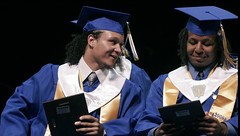Leading by Doing
 Jachlin Leatherman and Wayne Nesbit graduating from Ballou High School, Washington DC. Washington Post photo by Marvin Joseph.
Jachlin Leatherman and Wayne Nesbit graduating from Ballou High School, Washington DC. Washington Post photo by Marvin Joseph.Excerpt from the article "For the Love Of Ballou," subtitled "2 Scholar-Athletes Made a Private Pact: To Nurture Hope at a Troubled School," one of the articles published in the Post series "Being a Black Man."
On their first day of high school, Wayne and Jachin met in the cafeteria before classes began and talked about how excited they were by what was ahead. The freedom of high school life. The party atmosphere of Ballou.
Soon, though, they were noticing how many students would show up for school but never go to class. And the closer they paid attention to the classes where students did show up, such as biology, the more they realized how difficult improving Ballou would be.
"People would come to class and didn't do their work. People around us were getting C's and D's -- and they didn't really care," Jachin said. "We realized how much work it would take to get others around us wanting to do good. We realized it was going to be a tough job."
In that first year, they didn't have much effect at all, other than establishing themselves as students with high expectations in a place where low expectations were often viewed as good enough.
In 10th grade, though, when Jachin and Wayne made the football team, things began to change, if ever so slightly. Most of the players were barely making the 2.0 grade-point average necessary to stay on the team, and when the coaches realized they now had two straight-A students in their midst, they used Jachin and Wayne to full advantagee.
The coaches established mandatory study sessions at 7:30 in the morning and in the hour between the end of classes and practice, putting Wayne and Jachin in charge. Math, English, social studies -- whatever a player asked about, Wayne or Jachin would help. As the football season continued, they felt they were making progress. Perhaps they couldn't affect a broad spectrum of students, but they could affect their teammates. .
This relates to my point, my being against an "education rights" charter amendment to the Home Rule Charter of the District of Columbia. As I said in this blog entry, "School daze continued":
1. It should be understood as a matter of course that all District government agencies should provide excellent services.
2. It opens the District Government up (i.e., our taxpayer-generated revenue stream) to terrible legal liabilities.
3. The advocates for this charter amendment are not offering other amendments simultaneously to make the DC Public Schools manageable and accountable.
4. The advocates are not acknowledging "inputs" issues on the children-parent side of the equation.
A lot more must be done along the lines of what these students did, on the student inputs side of the equation, as well as on the school-provided inputs side, to make a difference. Continuing to apply more of the same thinking won't make any difference. Also see these blog entries, among others:
-- Positive deviance and DC Public Schools
-- Thinking about schools
-- School daze
-- If money fixed everything wouldn't we have a great society ...
-- Involving the community in school improvement.
________
Update: The Post editorialized along these same lines on Sunday, in this piece: "How Not to Fix D.C. Schools."
Index Keywords: education



0 Comments:
Post a Comment
<< Home